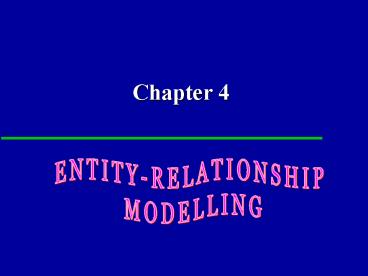Database Systems - PowerPoint PPT Presentation
1 / 40
Title:
Database Systems
Description:
How to use Entity Relationship (ER) modeling in database design. ... How to build an ER model from a requirements specification. 3 ... – PowerPoint PPT presentation
Number of Views:87
Avg rating:3.0/5.0
Title: Database Systems
1
Chapter 4
ENTITY-RELATIONSHIP MODELLING
2
Chapter 4 - Objectives
- How to use EntityRelationship (ER) modeling in
database design. - Basic concepts associated with ER model.
- How to build an ER model from a requirements
specification.
3
ER Diagram of Branch View of DreamHome
4
Concepts of the ER Model
- Entity types
- Relationship types
- Attributes
5
Entity Type
- Entity type
- Group of objects with same properties,
identified by enterprise as having an independent
existence. - Entity occurrence
- Uniquely identifiable object of an entity type.
6
Examples of Entity Types
7
ER Diagram of Staff and Branch Entity Types
8
Relationship Types
- Relationship type
- Set of meaningful associations among entity
types. - Relationship occurrence
- Uniquely identifiable association, which includes
one occurrence from each participating entity
type.
9
Semantic Net of Has Relationship Type
10
ER Diagram of Branch Has Staff Relationship
11
Relationship Types
- Degree of a Relationship
- Number of participating entities in
relationship. - Relationship of degree
- two is binary
- three is ternary
- four is quaternary.
12
Binary Relationship called POwns
13
Ternary Relationship called Registers
14
Quaternary Relationship called Arranges
15
Relationship Types
- Recursive Relationship
- Relationship type where same entity type
participates more than once in different roles. - Relationships may be given role names to indicate
purpose that each participating entity type plays
in a relationship.
16
Recursive Relationship called Supervises with
Role Names
17
Entities associated through two distinct
Relationships with Role Names
18
Attributes
- Attribute
- Property of an entity or a relationship type.
- Attribute Domain
- Set of allowable values for one or more
attributes.
19
Attributes
- Simple Attribute
- Attribute composed of a single component with an
independent existence. - Composite Attribute
- Attribute composed of multiple components, each
with an independent existence.
20
Attributes
- Single-valued Attribute
- Attribute that holds a single value for each
occurrence of an entity type. - Multi-valued Attribute
- Attribute that holds multiple values for each
occurrence of an entity type.
21
Attributes
- Derived Attribute
- Attribute that represents a value that is
derivable from value of a related attribute, or
set of attributes, not necessarily in the same
entity type.
22
Keys
- Candidate Key
- Minimal set of attributes that uniquely
identifies each occurrence of an entity type. - Primary Key
- Candidate key selected to uniquely identify each
occurrence of an entity type. - Composite Key
- A candidate key that consists of two or more
attributes.
23
ER Diagram of Staff and Branch Entities and
their Attributes
24
Entity Type
- Strong Entity Type
- Entity type that is not existence-dependent on
some other entity type. - Weak Entity Type
- Entity type that is existence-dependent on some
other entity type.
25
Strong Entity Type called Client and Weak Entity
Type called Preference
26
Relationship called Advertises with Attributes
27
Structural Constraints
- Main type of constraint on relationships is
called multiplicity. - Multiplicity - number (or range) of possible
occurrences of an entity type that may relate to
a single occurrence of an associated entity type
through a particular relationship. - Represents policies (called business rules)
established by user or company.
28
Structural Constraints
- The most common degree for relationships is
binary. - Binary relationships are generally referred to as
being - one-to-one (11)
- one-to-many (1)
- many-to-many ()
29
Semantic Net of Staff Manages Branch Relationship
Type
30
Multiplicity of Staff Manages Branch (11)
Relationship Type
31
Semantic Net of Staff Oversees PropertyForRent
Relationship Type
32
Multiplicity of Staff Oversees PropertyForRent
(1) Relationship Type
33
Semantic Net of Newspaper Advertises
PropertyForRent Relationship Type
34
Multiplicity of Newspaper Advertises
PropertyForRent () Relationship
35
Structural Constraints
- Multiplicity for Complex Relationships
- Number (or range) of possible occurrences of an
entity type in an n-ary relationship when other
(n-1) values are fixed.
36
Semantic Net of Ternary Registers Relationship
with Values for Staff and Branch Entities Fixed
37
Multiplicity of Ternary Registers Relationship
38
Summary of Multiplicity Constraints
39
Structural Constraints
- Multiplicity is made up of two types of
restrictions on relationships cardinality and
participation. - Cardinality
- Describes maximum number of possible relationship
occurrences for an entity participating in a
given relationship type. - Participation
- Determines whether all or only some entity
occurrences participate in a relationship.
40
Multiplicity as Cardinality and Participation
Constraints































